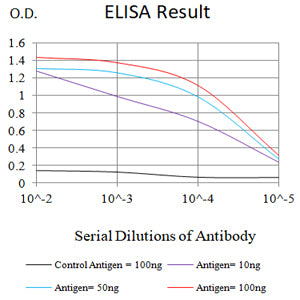
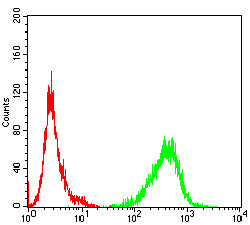
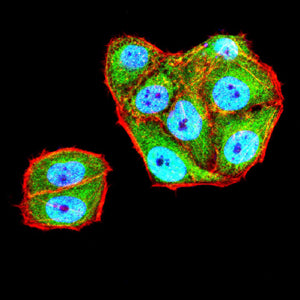
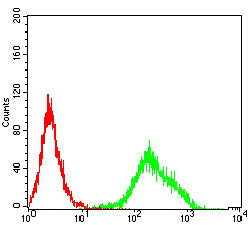
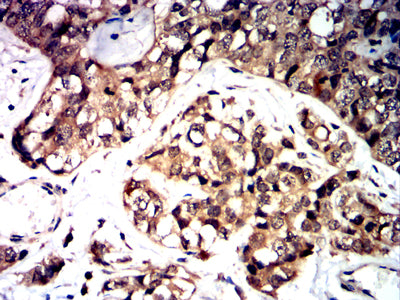
| WB | 咨询技术 | Human,Mouse,Rat |
| IF | 咨询技术 | Human,Mouse,Rat |
| IHC | 1/200 - 1/1000 | Human,Mouse,Rat |
| ICC | 1/200 - 1/1000 | Human,Mouse,Rat |
| FCM | 1/200 - 1/400 | Human,Mouse,Rat |
| Elisa | 1/10000 | Human,Mouse,Rat |
| Aliases | HLALS |
| Entrez GeneID | 3140 |
| clone | 6A5B2 |
| WB Predicted band size | 39.4kDa |
| Host/Isotype | Mouse IgG2a |
| Antibody Type | Primary antibody |
| Storage | Store at 4°C short term. Aliquot and store at -20°C long term. Avoid freeze/thaw cycles. |
| Species Reactivity | Human |
| Immunogen | Purified recombinant fragment of human MR1 (AA: extra(23-302)) expressed in E. Coli. |
| Formulation | Purified antibody in PBS with 0.05% sodium azide |
+ +
以下是关于MR1抗体的3篇代表性文献示例(信息为示例性概括,具体内容请参考原文):
---
1. **文献名称**:*Structural insight into MR1-mediated recognition of the mucosal associated invariant T cell receptor*
**作者**:López-Sagaseta, J. et al.
**摘要**:该研究通过X射线晶体学解析了MR1-抗原复合物与MAIT细胞TCR的三元结构,揭示了MR1呈递微生物代谢产物抗原的分子机制,为基于MR1的抗体设计提供了结构基础。
---
2. **文献名称**:*Antibody-mediated targeting of MR1 inhibits tumor growth in experimental models*
**作者**:Bhattacharya, S. et al.
**摘要**:开发了靶向MR1的单克隆抗体,在体外和动物模型中验证了其通过阻断MR1抗原呈递功能抑制肿瘤细胞增殖的疗效,提示MR1抗体在癌症免疫治疗中的潜力。
---
3. **文献名称**:*MR1-restricted T cell immunity in bacterial infections: Implications for vaccine design*
**作者**:Gold, M.C. & Lewinsohn, D.M.
**摘要**:综述了MR1在细菌感染中的免疫调控作用,讨论了针对MR1-抗原复合物的抗体或疫苗如何增强MAIT细胞应答,可能成为抗感染治疗的新策略。
---
建议通过PubMed或Google Scholar搜索关键词“MR1 antibody”、“MR1 therapeutic target”获取最新文献。部分研究可能涉及抗体工程、表位定位或临床前试验方向。
MR1 (MHC class I-related molecule) is a non-classical MHC class I protein that plays a unique role in antigen presentation to mucosal-associated invariant T (MAIT) cells. Unlike classical MHC molecules that present peptide antigens, MR1 binds and presents microbial vitamin B2 (riboflavin) biosynthesis intermediates, such as 5-amino-6-D-ribitylaminouracil (5-A-RU), derived from bacteria and fungi. This interaction is crucial for MAIT cell activation, bridging innate and adaptive immunity.
Discovered in the 1990s, MR1 is highly conserved across mammals and broadly expressed in various tissues, particularly at mucosal surfaces. Its structure resembles classical MHC-I but lacks polymorphism, enabling recognition of conserved microbial metabolites. MAIT cells, which express a semi-invariant T-cell receptor (TCR), detect MR1-antigen complexes to initiate rapid immune responses against pathogens like Salmonella and Mycobacterium.
Research highlights MR1's dual role: it contributes to antimicrobial defense but may also promote inflammation in autoimmune diseases or cancer. Recent studies explore MR1-targeted therapies, including MAIT cell-based immunotherapies and MR1-restricted TCR-engineered T cells, showing potential for treating infections and malignancies. Its unique antigen-presenting mechanism makes MR1 a compelling subject for understanding immune regulation and developing novel therapeutic strategies.
×